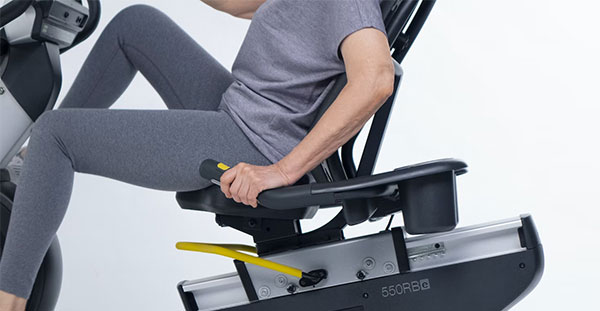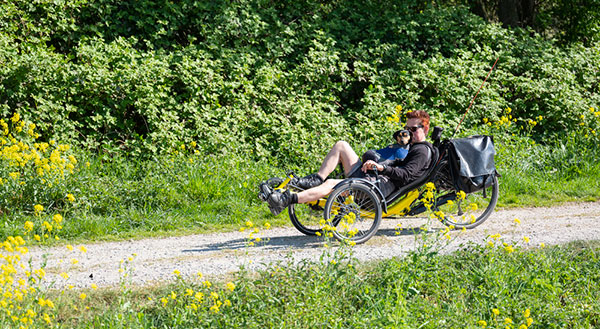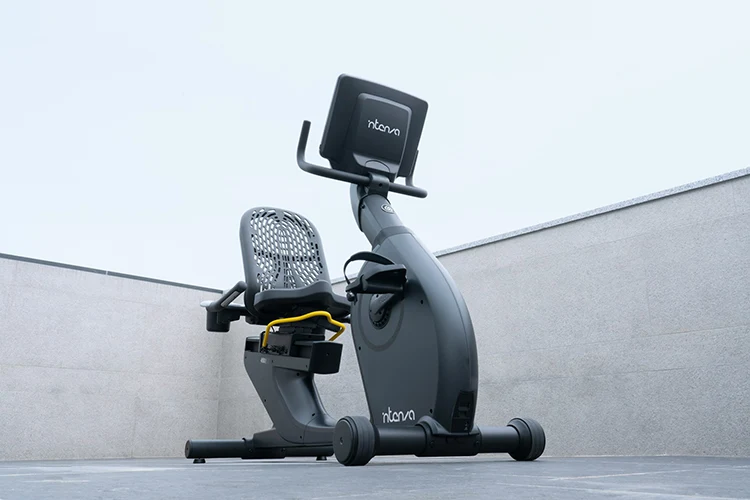Recumbent bikes are comfortable, easy on the joints, and great for the elderly. But recumbent bike benefits don’t stop there.
You can do a lung-busting workout on a recumbent bike. With a recumbent exercise bike, you could lean back and watch TV or pedal so hard that your legs burn and you’re soaked in sweat.
Designed for a wide variety of cyclists and fitness riders, recumbent exercise bikes are simpler and more forgiving than regular exercise bikes.
When it comes to stationary recumbent bikes, the benefits are twofold. You don’t need to balance or lean forward on a stationary recumbent bike. In fact, you can almost relax as you pedal away.
In many cases, recumbent bikes are specifically designed for those with back issues or degenerative diseases that cause limited mobility. The ‘recumbent’ position completely eases the back and allows the rider to pedal without doing damage to their joints.
Before we jump into our complete list of recumbent bike benefits, let’s talk about the difference between recumbent bikes and upright bikes.
Contents
Differences Between Recumbent Bikes and Upright Bikes
You may be wondering, what is a recumbent bike? A recumbent bike is a bike that puts you in a reclined pedaling position on a bike. Most recumbent exercise bikes are stationary recumbent bikes or indoor exercise bikes. But a few cyclists ride recumbent bikes outside.
Related: Best Exercise Bikes
The reclined position on a recumbent bike contrasts with the upright position on a regular bike.
Depending on the type of bicycle (e.g., road, mountain, hybrid, beach cruiser, etc.), your riding position may be upright or pushed forward and down. These riding positions put a strain on your lower back, as well as your upper body muscles, neck, and other joints.
The reclined position on a recumbent bike allows you to sit back like you are sitting in a chair.
Most recumbent bikes have handlebars next to the seat, which allows you to stabilize yourself while you ride. The pedals are out in front of you on a recumbent bike, and you can adjust the seat so that your knees are almost straight at the bottom of the pedal stroke.
On a regular bike, your legs are directly beneath your hips while your upper body is tilted forward.
Why Cyclists Choose Recumbent Bikes
Recumbent bikes are perfect for people with balance problems, back pain, or those who struggle with exercise. One of the main reasons that people choose cycling over walking or running is that cycling is non-weight-bearing.
Walking, running, hiking, and more on-your-feet activities are weight-bearing, which means that with each footstep, you are pushing a force through your foot that is at least as high as your body weight.
Weight-bearing activities come with a higher risk of injury than non-weight-bearing activities such as cycling or swimming. This is why cycling or swimming is often used for rehabilitation.
With their reclined cycling position, recumbent bikes take a significant amount of strain off of your lower back. They also take the weight off your hips, knees, and feet since cycling is a non-weight-bearing exercise.
Using a recumbent exercise bike can also be relaxing. You can easily watch television or read a book while pedaling away in the reclined position. With most of your body weight on the seat, your hands are free to hold a book, phone, tablet, or remote.
You can also make recumbent bike workouts very hard, which is great for recumbent bike riders who want to increase their fitness. For a harder workout, you can increase your pedaling cadence or the recumbent bike’s resistance to really break a sweat.
Recumbent Bike Benefits

Recumbent exercise bike benefits include improved fitness, comfort, safety, and injury rehab. Their unique positions allow you to take the stress off your bike and enjoy the ride injury-free.
There are many more benefits of a recumbent bike, for example:
Comfort
Recumbent exercise bikes are much more comfortable than regular bikes. On a regular bike, you will have to ride in an upright or forward position that places stress on your back, shoulders, and more. Riding a regular bike can be quite uncomfortable if you aren’t used to it.
In contrast, recumbent bikes allow you to sit and lean back while also getting a workout in. You can even watch TV, read a book, or catch up on emails while pedaling on a recumbent bike.
Recumbent bikes typically come with a full-size seat, like a chair, rather than the narrow saddles that you get on regular bikes. This improves comfort and reduces the chances of saddle soreness.
Easy on joints
Recumbent bikes are easy on joints, especially the hips, knees, ankles, and lower back.
In the reclined position, recumbent bikes take the weight off of your lower back, which is under quite a load on a regular bike.
Cycling is also a non-weight-bearing activity, but riding a regular bike can put a strain on your lower back, upper body, neck, and shoulders. Recumbent bikes put the majority of your weight on the cushioned seat, easing the pressure off your joints from head to toe.
Availability
A recumbent exercise bicycle can be found in most gyms, including small hotel set-ups during travel.
The availability of recumbent bikes is another factor that separates them from regular bikes, which are more common in cycling-specific studios rather than gyms.
Customization
Recumbent exercise bikes are incredibly customizable, both in their riding positions and workout features.
First, you can adjust the riding position on a recumbent bike in many ways, such as the saddle height, saddle fore and aft, and sometimes the position of the handlebars.
This allows almost anyone to ride a recumbent bike, from the elderly to experienced cyclists.
Workout Variety
You can also customize your workout on a recumbent bike, or it doesn’t have to be a workout at all. Many use recumbent bikes for rehabilitation since the exercise of cycling helps improve blood flow and joint mobility.
With the varying levels of resistance, you can create a hard workout on recumbent bikes, too. You can also increase or decrease your pedaling cadence or even pedal backward for a more challenging workout.
And, of course, you can always go on a recumbent bike for an easy spin or a light cardio session while catching up on your favorite book.
Safety
One of the main benefits of recumbent bikes is that they are safe in more ways than one. It is easy to sit and pedal on a recumbent bike because you don’t need to balance like on a regular bicycle.
Those with balance problems will feel much more comfortable on a recumbent bike compared to a regular bicycle.
Lastly, recumbent bikes are great for both injury prevention and rehab. The act of cycling is a perfect non-weight-bearing activity that can be used to improve your cardiovascular health as well as strengthen your leg muscles and joints.
Recumbent Bike Disadvantages

Stationary recumbent bikes are not perfect, and here we’ll run through some stationary bike disadvantages. Firstly, a recumbent bike is a focused lower-body exercise that is much easier than riding a regular bike.
On a regular bike, you will get a full-body cardiovascular exercise that also stresses your hands, arms, back, and neck. With recumbent bikes, your workout is limited to your lower body, even during high-intensity efforts.
Getting a hard workout on a recumbent bike can also be difficult. The reclined seating position is much easier on your back and joints but can also be more relaxing than challenging. This is great for those with limited fitness and mobility, but it also makes it harder to get a good workout in.
On a regular bike, you can access many training platforms, including virtual workouts on Peloton or Zwift.
Recumbent bikes have their own basic riding style, and you typically have to adjust the resistance yourself manually. All said recumbent bikes can be more boring than regular bikes, especially during long rides or hard workouts.
A recumbent bike can also cost more than a regular bike. Since recumbent bicycles are specifically built for individuals with limited mobility, they have a high-cost design that makes them more comfortable than practical.
At home, a recumbent bike can cost upwards of $3,000, whereas a regular bike can be bought for $1,000 within baseline models.
Lastly, recumbent bikes can be harder to maintain than regular bikes. Because recumbent bikes are much less popular than regular bikes, so there is a smaller market for those knowledgeable about recumbent bike maintenance and replacement parts.
If you are going to a gym to use a recumbent bike, then you needn’t worry. But if you have a recumbent bike at home, it can quickly become quite a hassle.
What Muscles Do Recumbent Bikes Work?
Thanks to their reclined seating position, recumbent bikes work muscles differently compared to regular bicycles. Of course, the lower body muscles are the main target of the exercise, but they are worked in a different way on a recumbent bike.
In the recumbent bike position, your legs are out in front of you, so you can’t use gravity to assist your pedal stroke in the same way that you can on a regular bike. However, many of the same muscles are worked on both recumbent bikes and regular bikes.
Recumbent bike muscles worked include the quadriceps, hamstrings, shins, calves, and glutes. Riding a recumbent bicycle can improve your muscle strength and endurance through easy rides and hard workouts.
Riding a recumbent bicycle can also improve your flexibility, range of motion, and balance. Even in the reclined position, recumbent cycling can improve the range of motion in your hips, as well as your lower limb flexibility.
Lastly, recumbent cycling improves your blood circulation, which is especially important for the elderly and rehabilitation patients.
FAQ
Can you get fit on a recumbent bike?
Recumbent bicycles are a great workout. Depending on the resistance and your pedaling cadence, you can ride easy, medium, or hard on a recumbent bike. Recumbent bikes have a number of benefits, such as improving your cardiovascular health, rehabilitation, and strengthening your lower body muscles and joints.
What parts of the body does a recumbent bike work?
A recumbent bike works your lower body muscles mainly. The pedaling motion strengthens your quadriceps, hamstrings, calves, hips, and ankles. You are also using your core and lungs while riding a recumbent bike, strengthening them in the process. During hard recumbent bike workouts, you can use your arms to hold onto the handlebars and your core to help stabilize your body as you pedal hard.
Why are recumbent bikes not popular?
Recumbent bikes are specifically designed for comfortable cycling for the elderly and those with limited mobility. Cycling is a non-weight-bearing activity, so even riding a regular bike is comfortable for most people. Nowadays, there are so many different styles of bikes with upright and comfortable positions, including beach cruisers and hybrids.
Recumbent bicycles use a reclined seating position that is quite unique. Many riders prefer the upright seating position on regular bikes. Lastly, recumbent bikes can be quite expensive and difficult to maintain at home. Otherwise, you'll usually have to go to a gym on a stationary recumbent bike.
What are the disadvantages of a recumbent bike?
Recumbent bikes use a reclined seating position that takes the pressure off your back and upper body. While this is beneficial for the elderly and those with limited mobility, it can be detrimental to other riders.
In the reclined seating position, some riders are actually less comfortable because of the difference in pedaling motion. Recumbent bicycles also provide a focused lower body exercise, but that is limiting in and of itself. On a regular bike, you can get a whole-body workout and cardiovascular exercise that strengthens your lower body and your core, shoulders, arms, and neck.
Is the recumbent bike good for weight loss?
Recumbent bikes are great for weight loss because they are a non-weight-bearing, cardiovascular exercise.
Non-weight-bearing activities such as cycling and swimming are perfect for people with balance problems, injury history, or old age.
While walking may be challenging or dangerous for the elderly, recumbent bicycles are a great way to fit in a cardio workout without worrying about injury.
Recumbent cycling can also burn 300-500 calories per hour and more than 500 calories per hour during a hard recumbent bike ride.
Is a recumbent bike as good as walking?
Recumbent bikes and walking are both cardiovascular exercises, but the main difference is that recumbent biking is non-weight-bearing. That means that you aren't putting a heavy load onto your joints during recumbent cycling, but you are walking.
During a walk, you are putting at least the force of your body weight through your foot with every step. For the elderly or those with injury or balance problems, walking can be a big challenge.
Both recumbent biking and walking have similar benefits for your cardiovascular health, but recumbent biking is much safer, more comfortable, and better for injury prevention.
Are recumbent bikes good for your back?
Recumbent bikes are good for your back when they are set up in the correct position. That means adjusting the seat height and fore and aft so that the recumbent bike fits your unique body size. There should be no strain on your lower back in the correct position.
While regular bikes can hurt your back (due to the upright position), recumbent bikes help take the stress off your back and other lower body joints using a reclining position.




